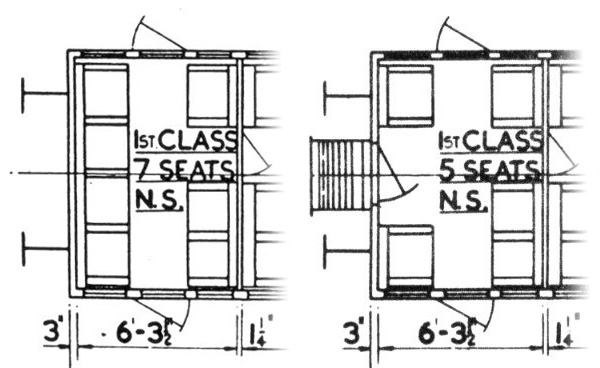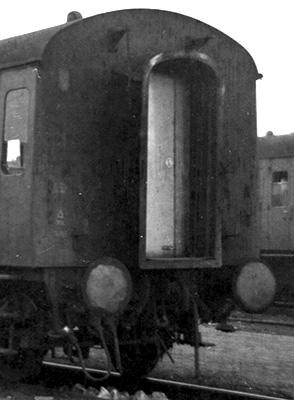Class 117 Pressed Steel 3-car DMUs
Gangways
The sets were not gangwayed when new. However there was always through access inside the individual vehicles - the interior partitions having doors - unlike some high-density vehicles.
Sample images showing the non-gangwayed ends: power car; centre car 1st class end (water pipes and steps), 2nd class end (lighting controller).
Gangways were added later, and the first to be treated is believed to be set RDG 311 (51395 + 59505 + 51395) circa June 1965[1]. By Autumn there were at least another three converted allowing them to be strengthened to four-cars, initially with converted hauled stock (the Hawksworth coaches) and then other DMU trailers (Met-Camm centre cars).[2] This image taken on 2/11/65 shows the gangway between 51381 and 59491.

For the DMBS there was no change in seating capacity when the gangway was added, the DMS would be reduced from 91 to 89 as the six-seater on the back wall was replaced by a two plus two to allow the gangway in between. The TCL would be reduced from 24 first / 50 second to 22 first / 48 second.
The image show the change to the first class end of the TCL as noted on the vehicle diagrams. All the before and after diagrams can be found on the diagram page.
When a new series of set numbers were introduced in January 1968 (4xx series replacing the 3xx series), the sets were divided by whether they were gangwayed or not. Twenty-five sets were now gangwayed, becoming 400-424 (all allocated to Reading) while sets 450-466 (17 sets) were not gangwayed, allocated to Southall.[3]
Diagram Confusion
There is some confusion over which vehicles were gangwayed and which were not at this time. The re-issued diagrams list the vehicle numbers of those treated, and these numbers are the opposite of what they actually were.

If we use the DMS as an example - the original diagram 535 as an un-gangwayed vehicle has all 42 cars listed. It would be re-issued with a reduced number of vehicles (25), the diagram clearly showing an un-gangwayed vehicle. The DMBSs with gangway became diagram 852, this listed 17 gangwayed vehicles. But as noted above, at this time there 25 gangwayed sets and 17 non-gangwayed! Notes in various issues of Railway Observer and the Ian Allan ABCs showed which vehicles were gangwayed, and the image of 51381 and 59491 noted above all support the fact that the numbers on the BR diagram sheets are reversed.
The image shows the gangway fitted to the second class end of TCL 59516, circa late 1960s. The gangways were of the 'suspended' type used for many years on GWR stock.

Soon after the remainder would begin to have gangways added for 'Paytrain' operations, it seems another five sets were gangwayed by 1970[4] and all had been treated by the end of 1973.[5]
The final image shows the corridor connection between GWR liveried power-twin 51410 and 51368 at Penzance on 16th April 1995. Robert Chilton.
References
- ⋏ p277 August 1965 Railway Observer
- ⋏ p392 December 1965 Railway Observer
- ⋏ p101 March 1968 Railway Observer
- ⋏ 1970 DMU Ian Allan ABC
- ⋏ The Coaching Stock of British Railways 1974 P. Mallaband and L.J. Bowles, RCTS
The Railway Observer is the journal of the Railway Correspondence and Travel Society
Summary
Orders
Description
Gangways
Diagrams
Works Photographs
Numbering & Driving Inst.
Set Numbers
Liveries
Operations
Refurbishment
Non-Passenger Use
Images
Details about preserved Class 117s can be found here.


